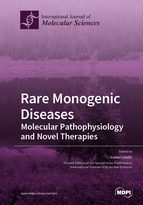Rare Monogenic Diseases: Molecular Pathophysiology and Novel Therapies
A special issue of International Journal of Molecular Sciences (ISSN 1422-0067). This special issue belongs to the section "Molecular Pathology, Diagnostics, and Therapeutics".
Deadline for manuscript submissions: closed (15 September 2021) | Viewed by 62794
Special Issue Editor
Interests: frataxin; Friedreich’s ataxia; mitochondria; programmed cell death; molecular medicine
Special Issues, Collections and Topics in MDPI journals
Special Issue Information
(This is a new joint type of Special Issue belongs to IJMS journal and Encyclopedia platfrom, you can get more information from https://encyclopedia.pub about Encyclopedia platfrom)
Dear Colleagues,
Most rare diseases we know arise from single gene mutations. In fact, the number of rare monogenic diseases is growing continuously, and to date, near 4000 single-gene inherited disorders have been characterized. Pathogenic mutations typically affect the coding regions, thus resulting in classical amino acid substitutions responsible for loss- or gain-of-function in protein products. However, several disease-causing defects originate from regulatory and non-coding DNA regions, ultimately affecting gene expression by transcriptional and/or post-transcriptional mechanisms.
Understanding the molecular pathophysiology of a rare monogenic disease has a double value. The identification of alterations that occur in specific genes, proteins, and pathways allows the translation of scientific advances into novel therapeutic approaches for these traits. Moreover, the investigation of rare monogenic diseases has the power to reveal fundamental biological mechanisms that would otherwise remain unknown.
This Special Issue will focus on the key molecular mechanisms that are affected within a rare monogenic disorder, such as those involving gene expression, molecular pathways, redox homeostasis, organelle stress, and cell death. Studies addressing new experimental therapies to target specific mechanisms in a monogenic disease, including drug discovery, drug repositioning, gene therapy, and protein- and nucleic acid-based therapeutics are relevant to this Special Issue. Original research articles and systematic reviews are welcome.
Dr. Ivano Condò
Guest Editor
Manuscript Submission Information
Manuscripts should be submitted online at www.mdpi.com by registering and logging in to this website. Once you are registered, click here to go to the submission form. Manuscripts can be submitted until the deadline. All submissions that pass pre-check are peer-reviewed. Accepted papers will be published continuously in the journal (as soon as accepted) and will be listed together on the special issue website. Research articles, review articles as well as short communications are invited. For planned papers, a title and short abstract (about 100 words) can be sent to the Editorial Office for announcement on this website.
Submitted manuscripts should not have been published previously, nor be under consideration for publication elsewhere (except conference proceedings papers). All manuscripts are thoroughly refereed through a single-blind peer-review process. A guide for authors and other relevant information for submission of manuscripts is available on the Instructions for Authors page. International Journal of Molecular Sciences is an international peer-reviewed open access semimonthly journal published by MDPI.
Please visit the Instructions for Authors page before submitting a manuscript. There is an Article Processing Charge (APC) for publication in this open access journal. For details about the APC please see here. Submitted papers should be well formatted and use good English. Authors may use MDPI's English editing service prior to publication or during author revisions.
Keywords
- Monogenic disease
- Gene expression
- Molecular pathways
- Organelle dysfunctions
- Molecular medicine
- Drug discovery
- Molecular therapy







